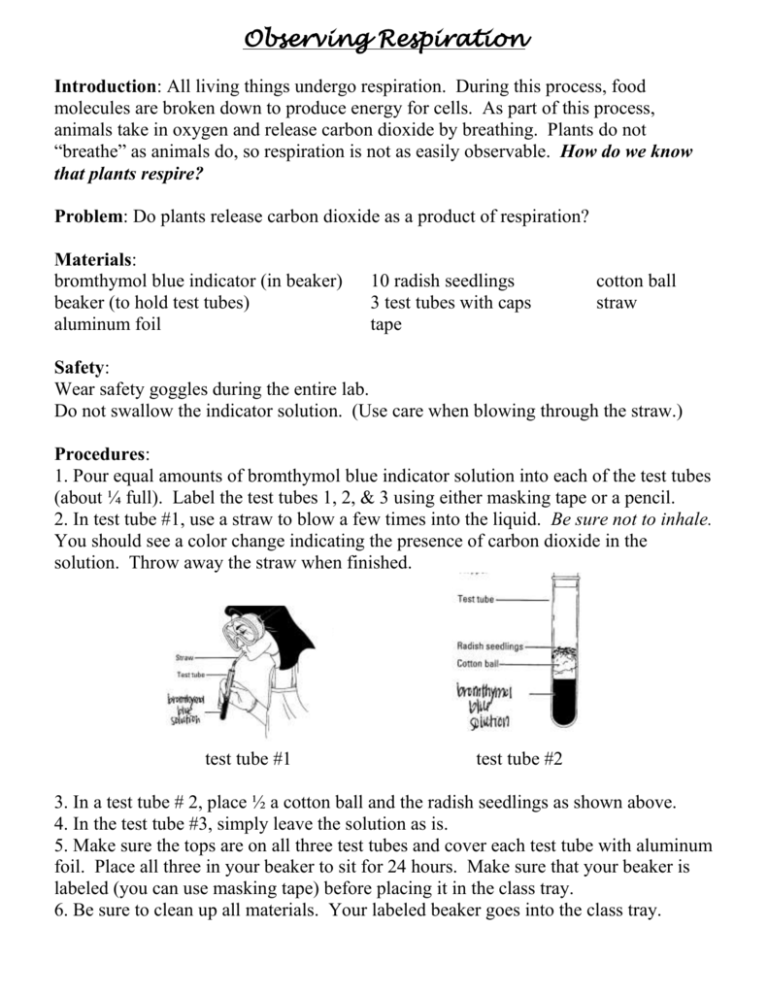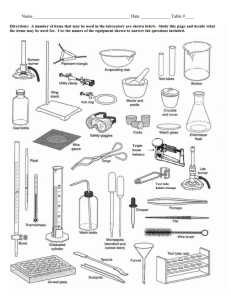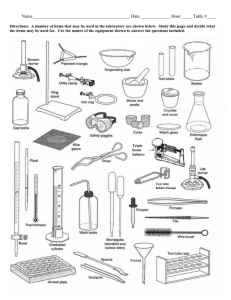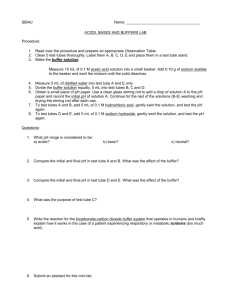Respiration Lab
advertisement

Observing Respiration Introduction: All living things undergo respiration. During this process, food molecules are broken down to produce energy for cells. As part of this process, animals take in oxygen and release carbon dioxide by breathing. Plants do not “breathe” as animals do, so respiration is not as easily observable. How do we know that plants respire? Problem: Do plants release carbon dioxide as a product of respiration? Materials: bromthymol blue indicator (in beaker) beaker (to hold test tubes) aluminum foil 10 radish seedlings 3 test tubes with caps tape cotton ball straw Safety: Wear safety goggles during the entire lab. Do not swallow the indicator solution. (Use care when blowing through the straw.) Procedures: 1. Pour equal amounts of bromthymol blue indicator solution into each of the test tubes (about ¼ full). Label the test tubes 1, 2, & 3 using either masking tape or a pencil. 2. In test tube #1, use a straw to blow a few times into the liquid. Be sure not to inhale. You should see a color change indicating the presence of carbon dioxide in the solution. Throw away the straw when finished. test tube #1 test tube #2 3. In a test tube # 2, place ½ a cotton ball and the radish seedlings as shown above. 4. In the test tube #3, simply leave the solution as is. 5. Make sure the tops are on all three test tubes and cover each test tube with aluminum foil. Place all three in your beaker to sit for 24 hours. Make sure that your beaker is labeled (you can use masking tape) before placing it in the class tray. 6. Be sure to clean up all materials. Your labeled beaker goes into the class tray. Name:_______________________ Period:___ Observing Respiration Lab Answer Sheet Answer all questions below. Each person should turn in their own answers. Day 1: 1. What color did the bromthymol blue indicator turn when carbon dioxide was added (test tube #1)? __________________________________________________________ 2. Hypothesis: 10 radish seedlings were placed in test tube #2. What do you expect to happen as the test tube sits for 24 hours? ____________________________________ Why? ________________________________________________________________ 3. Why cover the test tubes with aluminum foil? ______________________________ _________________________________________________________________ 4. What purpose does test tube #3 serve (the one left as is)? ______________________ _________________________________________________________________ Bring your answers to class tomorrow to finish the lab. Day 2: 1. Observe your test tubes and fill in the following table: test tube description of contents color of indicator solution 1 2 3 2. Did the color of the indicator change in the test tube that contained the radish seedlings? ____________________________________________________________ Explain the reason.______________________________________________________ 3. Compare the reaction that occurred in the test tube that contained the radish seedlings (test tube #2) with the one that occurred in the test tube into which you exhaled (test tube #1). How are they similar? _________________________________ _________________________________________________________________ 4. How might your results been affected if you had used more seedlings or fewer seedlings? _____________________________________________________________ 6. Why is the process of cellular respiration common to all forms of life? ___________ _________________________________________________________________






